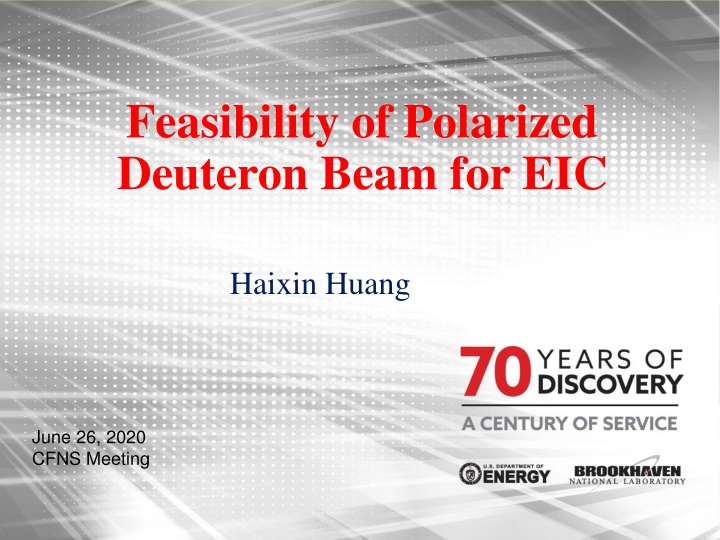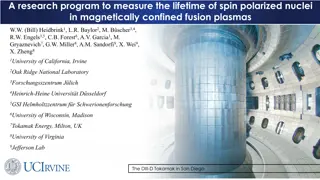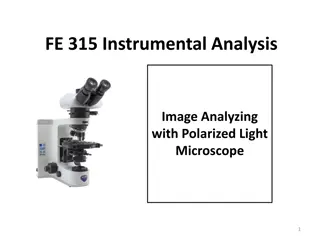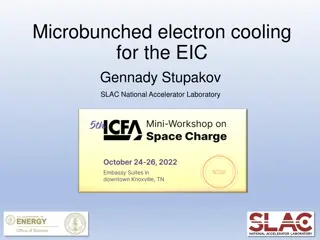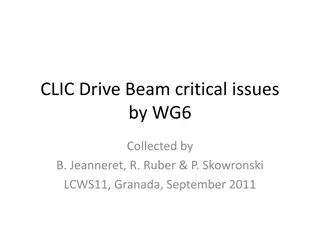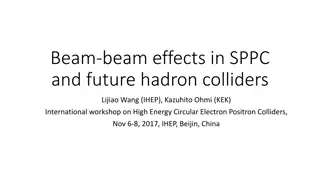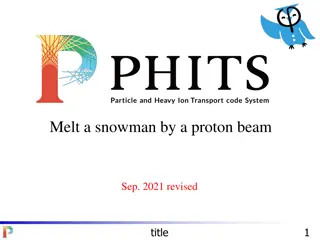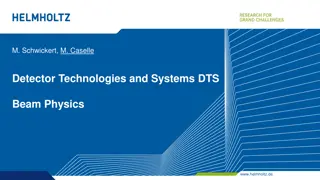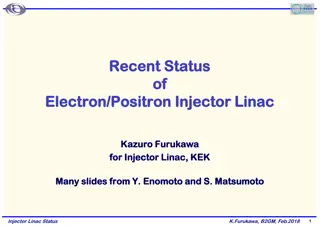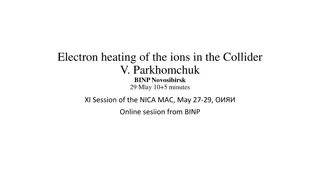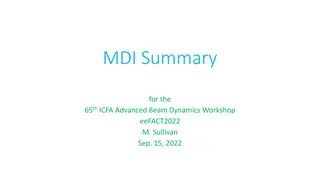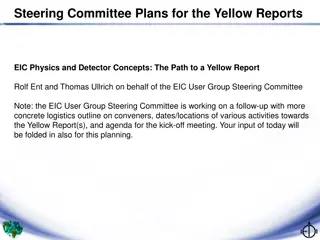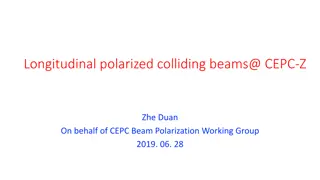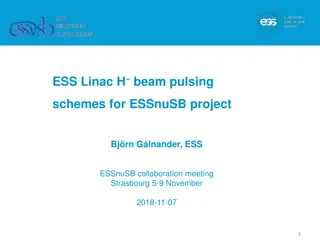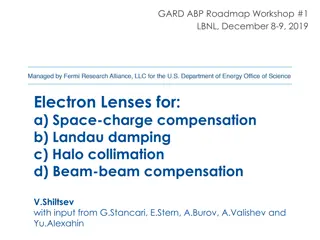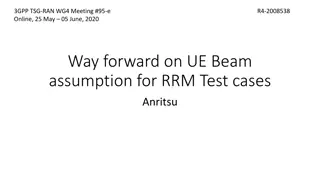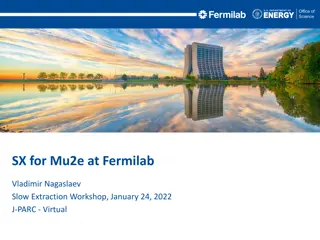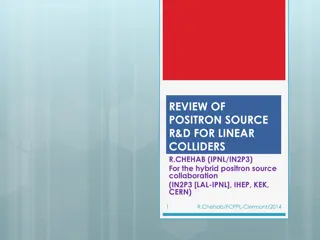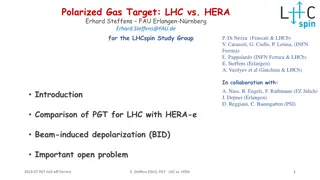Feasibility of Polarized Deuteron Beam for EIC
Polarized deuterons have been studied for acceleration in RHIC and EIC. Previous work by S.Y. Lee and E. Courant explored methods such as Siberian snakes and tune jump systems. Scenarios for polarized deuterons have been considered, including the use of detector solenoids as partial snakes. Further research is needed to assess the practicality of using polarized deuterons in these facilities.
Download Presentation

Please find below an Image/Link to download the presentation.
The content on the website is provided AS IS for your information and personal use only. It may not be sold, licensed, or shared on other websites without obtaining consent from the author.If you encounter any issues during the download, it is possible that the publisher has removed the file from their server.
You are allowed to download the files provided on this website for personal or commercial use, subject to the condition that they are used lawfully. All files are the property of their respective owners.
The content on the website is provided AS IS for your information and personal use only. It may not be sold, licensed, or shared on other websites without obtaining consent from the author.
E N D
Presentation Transcript
Feasibility of Polarized Deuteron Beam for EIC Haixin Huang May. 29, 2019 June 26, 2020 CFNS Meeting
Polarized Deuterons in EIC/RHIC Unpolarized deuteron beam has been used in RHIC during ion physics program. There is interest to run physics experiment with polarized deuterons. The possibility of acceleration of polarized deuteron in RHIC was evaluated in the past (S.Y. Lee and E.D. Courant) and shown feasible. In EIC hadron ring Small deuteron G: Much higher magnetic field required for spin rotation (Siberian Snakes not feasible) But: Weaker resonances Small number of resonances (makes it possible to deal with individual resonances) p 3He+2 d m, GeV 0.938 2.808 1.876 G 1.79 -4.18 -0.143 E/u, GeV 24-275 10-183 12-137 |G 45.5-525.5 48.5-818 1.6-20.9 2
What Have Been Studied Before S.Y. Lee and L. Ratner [NIM A306, 51(1991)] as well as E. Courant [BNL-65606(1998)] have explored the possibility of accelerating polarized deuteron in RHIC. S.Y. Lee s paper: 1. use existing Siberian snake as 0.5% partial snake for deuteron imperfection resonances; 2. use single turn tune jump system similar to 1980 s AGS jump quads for intrinsic resonances. E. Courant s paper: 1. add solenoid opposite the experiment IR for imperfection resonances; 2. use AC dipole for intrinsic resonances. Reality check: 1. the existing Siberian snake is too weak, only 0.015%; 2. the experiment solenoid are strong and should be considered; 3. single turn tune jump has caused significant emittance growth in the AGS experiment; 4. For some weak intrinsic resonances, the required oscillation amplitude is too large for the AC dipole method. In addition, the RHIC ramp rate assumed in above analysis is faster than reality and beam emittance was not considered in the analysis of intrinsic resonance. 3
Scenarios for Polarized Deuteron We have accelerated unpolarized deuteron in 2016. The beam emittance of such beam is known, rms 2 mm-mrad. The realistic RHIC ramp rate is known. The partial snake strength of the existing snake is only 0.015%, too weak to be used for deuteron. Waldo got similar result: it is smaller than 0.06%. We use blue lattice from run17 polarized proton run as the base. Since the vertical tune is not constrained by snake resonances as in the case for proton, the vertical tune can be different from 0.67. We use three tunes as examples: one at current pp working point y~0.673, and two with good lifetime from beam-beam simulation (Y. Luo): ( y~0.224, 0.175). 4
Detector Solenoid as Partial Snake? Experiment uses solenoid. What we need to consider are two scenario: EIC with Detector1 alone or EIC with Detector1 and Detector2. The solenoid field is not changed during experiment (as planned for Detector1). In the two-detector case, we are dealing with two partial snakes separated by pi/3. They may be strong enough to be used as partial snakes to maintain deuteron polarization. Detector1 3T*5m=15Tm Detector2 1.4T*4m=5.6Tm 5
Polarized Deuterons in the Injectors G range in the Booster: -0.14 to -0.22. No imperfection resonance. If fractional tune is not between 0.14 and 0.22 (or 0.78-0.86), no need to concern about intrinsic one either. G range in the AGS: -0.22 to -1.6. One very weak imperfection resonance. Three intrinsic resonances but none of them is enhanced with superperiod of 12. For the given AGS ramp rate, none of these causes polarization loss. AtR line: With such a small G value and no snake in the AGS, the spin match in the AtR line is not an issue. Tracking shows that there would be no visible spin mismatch. 6
Vertical Spin in AtR line for Deuteron and Proton (Tracking by Francois) Left: The vertical spin for deuteron. Right: the vertical spin fore proton. Note that due to large G value for proton, the spin rotations around horizontal and vertical is not commutable, and there is an effect on spin direction. For deuteron, due to the smaller value of G, the effect is negligible. 7
Resonance Strength for Deuterons (DEPOL) (from Vahid) From the d-Au run in 2016, the expected rms emittance of deuteron should be less than 2 . The rms orbit error is expected around 0.3mm. The resonance strengths are estimated with these beam conditions for run17 pp lattice ( y=29.673). 8
Imperfection Resonance for Deuterons G range: -1.6 to -20.9. Total of 19 imperfection resonances. With rms orbit error of 0.3mm, the strongest resonance strength is less than 0.0015. From the nominal ramp rate in RHIC d-Au run in 2016, the ramp rate is about d /dt= 90/220s =>resonance crossing rate =1.2E-7. A partial snake can be used to overcome these resonances. The required partial snake snake strength is 0.22%(see next page). The existing snake is not strong enough. Adding a solenoid is a solution. 15Tm warm solenoid (0.22% partial snake) should work. AGS Solenoid: 4.7Tm and 2.4m long. On the other hand, we have detector solenoids .. 9
Needed Partial Snake Strength for Deuterons G from -1.6 to -20.9. Total of 19 imperfection resonances. With rms orbit as 0.3mm, the strongest imperfection resonance is 0.0015. From the nominal ramp rate in RHIC d-Au run in 2016, the ramp rate is about d /dt= 90/220s =>resonance crossing rate =1.2E-7. Given the crossing speed of 1.2e-7/turn, The strength S/ needs to be much larger than 0.00355. It can be set as 0.0045 or 0.45% partial snake. At top energy, this corresponds to a 15Tm solenoid. 10
Spin Tune and Stable Spin Direction with 2 Partial Snakes Above are the spin tune and stable spin direction with two partial snakes separated by 2 /m. Only horizontal and longitudinal components are dependent on the orbit angle. 11
Imperfection Resonance Strength and Partial Snakes The partial snake strength with single and two partial snakes are included. The two detector solenoids are strong enough for polarization preservation through RHIC energy range. 12
Polarization after Each Imperfection Resonance The polarization after each imperfection resonance for a lattice with ?y =30.224. The polarization is preserved with two solenoids. 13
Spin Tune and Stable Spin Direction at Detector1 and Detecgor2 Detector1 Detecgtor2 Spin will be along the longitudinal direction at both IRs with G =3n. The effective spin tune will vary with a period of G =6. 14
Single Partial Snake Case (Detecgtor1 only) In this case, the spin is naturally longitudinal at G =int. at the IR. When = sin (G )= polarization will be along the longitudinal direction at every G =integer. Stable spin direction for a partial snake with longitudinal rotating axis is: Vertical Horizontal Longitudinal 15
Additional Consideration To maintain longitudinal polarization using a solenoid, the spin tune spread must be considered. Without a strong partial snake, the spin tune spread is given by At G = 18, spin tune spread is larger than the partial snake strength is 0.00225. We need to add orbit errors to enhance the imperfection resonance. This can be achieved by using a harmonic bump, to bring the rms orbit to the order of 4-6 mm at the given energy. This harmonic orbit bump is only required after acceleration is completed, thus not affect the resonance strength on the ramp. 16
Intrinsic Resonance Strength for Three lattices The two dash-lines are calculated with Gaussian distribution of 2 rms emittance. 17
Intrinsic Resonances The betatron oscillation is limited to 5 by aperture. This amplitude is not enough to use AC dipole to overcome all intrinsic resonances in the energy range. The 3-symmetry means the stronger resonance strength occurs at G = n+- y. However, due to the slow ramp rate, other resonances also can cause polarization loss. The strongest resonance is at | G = - y|, the strength is around 3.5e-3 for 2 beam. This resonance can fully flip spin. Others require a resonance crossing speed faster than 9.5E-5 to reach over 99% spin flip. 18
Modest Vertical Tune Jump For an isolated resonance, 2 = 2 1 Pf P e 2 0 And resonance crossing rate is given by: d d G = + d d With additional fast tune jump quads, the vertical tune can be changed quickly so that the effective resonance crossing speed is greatly increased. Then the polarization can be preserved according to the Froissart-Stora Formula. This technique has been applied in various synchrotrons in the past. 19
Tune Jump Schematics The spin tune spread at the highest intrinsic resonance is about 0.0265. The tune jump amplitude has to cover this range so all particles can benefit. Choosing 0.03 as the tune jump amplitude, the required number of turns would be fifty for the desired resonance crossing speed. 20
Tune Jump Qauds Power Supply Requirements The tr quads can change tune by 1 unit in 30ms. For 0.03 tune change, this is 900 s, or 70 turns. So it is not fast enough. Consider the 3-fold symmetry, we can add three jump quads, each can jump vertical tune by 0.01 in fifty turns. A tune jump system consisting of three quads and three power supplies of 1000A, 100V should work. In comparison, the AGS vertical tune jump system used in 1980s requires 2000A, 15kV with rise time of 1.6 s; and the AGS horizontal tune jump system requires 1400A, 600V. 21
Polarization after Each Res. for Various Schemes The 0.03 tune jump is good except at | y-12|, which can be overcome by normal ramp without firing tune jump quads. The overall efficiency for the tune jump method plus normal ramp across | y-12| is 95%. 22
Summary Polarized deuteron possibility in EIC has been explored. The imperfection resonances can be overcome by the planned detector solenoids for EIC (15Tm or combined with 5.6Tm). At G =3n (3, 6, 9, 12, 15, 18), longitudinal polarization can be reached at both 6 o clock and 8 o clock IRs. The intrinsic resonance can be overcome with modest tune jump. The required power supplies are smaller than the ones used in the AGS. The biggest challenge is deuteron polarimeter but it is not the topic of this study. Details of this study can be found at: Polarization preservation of polarized deuteron beams in the electron ion collider at Brookhaven National Laboratory, H.Huang, F. Meot, V. Ptitsyn, V. Ranjbar, and T. Roser, PRAB 23, 021001(2020). 23
